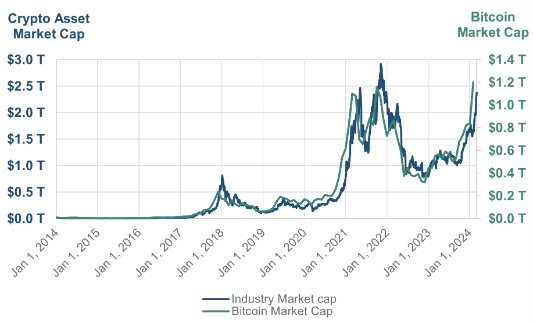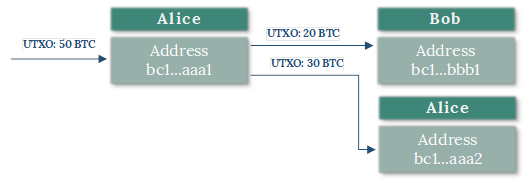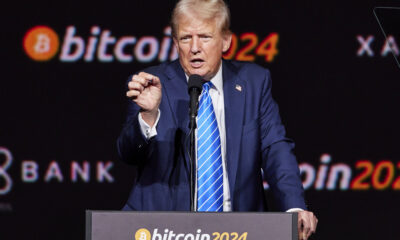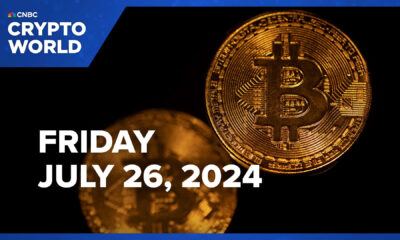Tech
Crypto Asset Investigations: Key Considerations And Pitfalls – Fin Tech

Crypto assets are some of the most rapidly
evolving and increasingly adopted assets in the world.
Decentralized Finance (DeFi) is emerging as a blockchain-based
alternative to traditional banking and financial services and has
seen dramatic growth in conjunction with the growth and development
of cryptocurrencies and blockchain technology. The associated
regulation and guidance for investigation and enforcement is
constantly evolving given the early-stage nature of this
industry.
The crypto and DeFi industry has seen a growing number of
regulatory enforcement actions as developers and founders push the
boundaries of these fintech applications into areas of our existing
financial regulations that were established well before the concept
of crypto assets was contemplated. In the United States, the number
of Security and Exchange Commission (SEC) enforcement actions
related to crypto assets has steadily increased over the last
decade, from a total of 11 between 2012 and 2017 to 128 between
2018 and 2023 (Figure 1).
1
Figure 1: Growth of Digital Asset
Enforcement Actions by the SEC
Source: SEC.gov
The rise in SEC enforcement actions related to crypto assets has
coincided with significant growth in the total market cap of the
crypto asset industry, which has seen a precipitous rise since
2017. Bitcoin represents the largest share of the overall crypto
asset industry market cap, currently representing approximately
one-half of the total market cap for all crypto assets.
(Figure 2).
Figure 2: Market Capitalization of the
Crypto Asset Industry and Bitcoin

Source: CoinMarketCap.com
The SEC’s first noticeable increase in crypto asset
enforcement actions was in 2018, which followed an all-time high in
the price of Bitcoin and in the industry market cap in December
2017. Similarly, enforcement actions increased in 2021 when the
overall industry market cap and Bitcoin again reached all-time
highs. Given this trend, it seems likely that the SEC and other
regulators and enforcement agencies will continue to increase their
focus on the crypto asset industry.
With the rise of crypto asset enforcement actions and other
related litigation, investigators must familiarize themselves with
the nuances and mechanics in the crypto asset industry,
particularly on the differences to investigations solely involving
traditional financial assets. Below, we will outline some of the
key considerations and major pitfalls that investigators may
encounter on investigations involving crypto assets.
The Basics
It is critical that investigators understand the type of crypto
assets that they are working with and how users will transact with
those assets. A wide variety of crypto assets exist with many
different transaction types, and understanding the nuances between
these assets and transactions is necessary in properly analyzing
the activity and tracing the flow of funds through blockchains and
off-chain entities.
While each crypto asset is unique in terms of its functionality,
supply and distribution characteristics, each crypto asset can be
generally categorized as either a native asset to a specific
blockchain (or a cryptocurrency
coin) or an asset that is built on top of
and operable with an existing blockchain (or a crypto
asset token).
Cryptocurrency coins are necessary to transact with or interact
with the blockchain that the coins are native to and are critical
to the operation of independent blockchains (e.g., Ether
is the native coin of the Ethereum blockchain). Each transaction on
a blockchain requires fees to be paid in the native asset and these
assets are critical to the security and consensus mechanism for
that blockchain, including rewarding blockchain participants for
validating transactions executed on each respective blockchain.
Conversely, crypto asset tokens are digital assets built on top
of and supported by a blockchain but are not native to a
blockchain. The characteristics of these tokens can vary widely,
however, they can be further classified as
fungible tokens or
non-fungible tokens (NFTs). A fungible
token shares the same rights and characteristics as all the other
tokens created by that token’s smart contract. Each fungible
token holds the same value and is interchangeable with every other
identical fungible token issued by the same smart contract. A
non-fungible token is one that is distinct from all other tokens
and does not have the same rights or characteristics of other
non-fungible tokens created by that token’s smart contract.
Wallet and Address Identification
One of the most critical aspects of a cryptocurrency
investigation is the identification of specific addresses and
wallets to analyze. Blockchains and cryptocurrencies inherently
provide a level of privacy and confidentiality as a feature of the
system known as pseudonymity, meaning that users interact with the
blockchain via a public cryptographic address as opposed to using
their full identity. Despite this privacy feature afforded to
users, because blockchains are immutable public ledgers, the
transactional and balance data of each address can always be
accessed and analyzed by investigators experienced in blockchain
forensics, and this data can be used to determine the ownership of
crypto asset addresses.
There are several methods to determine the identity of the
user(s) of a crypto asset address and/or wallet. In some cases,
individuals or entities may publicly identify their own public
addresses on social media platforms or web forums, or they may have
provided their addresses in documents included in the legal
discovery process. Additionally, because of the increased know your
customer (KYC) and anti-money laundering (AML) regulations imposed
in certain jurisdictions, users are more frequently required to
provide their identities to gain access to the services offered by
centralized crypto institutions, such as crypto exchanges. While
these entities are typically reluctant to share information about
their users, sound analysis prepared by an experienced investigator
combined with a court order or subpoena can be leveraged to obtain
relevant account information for target individuals or entities
using their platform.
Finally, identification of individuals or entities can be
achieved through the analysis of blockchain activity to link
blockchain addresses and transactions to addresses previously
identified through other means throughout the investigation. This
concept is similar to the Mosaic Theory in finance, whereby
cryptocurrency investigators can gather and analyze data from a
wide variety of sources to develop a probabilistic understanding of
address ownership that is not available from one single source of
data. Once investigators have identified the addresses and wallets
of individuals related to the investigation, they can subsequently
work forward or backward to trace assets associated with that
individual and identify additional addresses of interest.
Blockchain Data Sources
Leveraging the public nature of blockchain transactions is of
the upmost importance to a successful crypto asset investigation.
Investigators will need to extract and analyze public blockchain
data to identify transactions that occurred on-chain. Subsequently,
this data may need to be supplemented with account data from
centralized exchanges or over-the-counter (OTC) trading desks,
which can be obtained through subpoenas or legal discovery as noted
above.
A publicly available, widely accessible (and free) source of
blockchain data is block explorers, which are web-based blockchain
data interfaces that provide a relatively straightforward means for
users to explore and search for certain data recorded on a
blockchain, including transactions, addresses, and smart contract
code. Prominent blockchains, such as Bitcoin and Ethereum, have
extremely reliable and well tested block explorers (i.e.,
Blockchain.com for Bitcoin, Etherscan for Ethereum).
Conversely, smaller or less used blockchains may have limited
block explorers that lack proper technical support, offer poor user
interfaces, or may have no usable public block explorer at all, and
the reduced reliability, usability, and completeness of those tools
may complicate blockchain forensics and investigative procedures.
In some cases, the block explorers may be built by the same
individuals who designed the blockchain, and these insiders may
have an incentive to sensor or falsify blockchain activity that
appears on the block explorer interface available to users.
When investigating transactions, addresses, or protocols built
on blockchains without reliable block explorers, it is critical
that investigators conduct testing on the reasonableness and
completeness of the data sources being used. Inconsistencies or
discrepancies in data presented on the block explorer or between a
block explorer and another blockchain analytics tool may be
indicative of an unreliable block explorer. When there is any
concern regarding the quality or completeness of a block explorer,
investigators should either run their own blockchain node to access
the full history of that blockchain or consider relying on other
blockchain data providers who are running their own node.
Finally, investigators will need to obtain and understand data
from centralized exchanges, OTC desks, or other entities who
execute transactions involving crypto assets
off-chain. These entities provide trading
and other services for their users on their own systems and not on
the public blockchain (i.e., off chain). As a result,
investigators can trace and analyze crypto asset transactions using
public sources until it is sent to a centralized, off-chain entity.
In order to continue the tracing of crypto assets, investigators
will need internal account and transactional records from these
entities. As noted above, it is not a guarantee that you will be
given access to records from these entities depending on their
jurisdiction and willingness to cooperate with the investigation.
Additionally, even when requested data is provided, the data
points, formatting, and account structure in the documentation
received can vary widely.
Crypto Asset Tracing
The methodologies and assumptions used to trace assets through
and across blockchains can result in substantial differences in the
conclusions reached by investigators and blockchain forensics
practitioners. While parallels exist between traditional financial
instruments and crypto assets when it comes to tracing
methodologies, there are several critical nuances that are unique
to cryptocurrencies, including the underlying model used by each
blockchain to process and record transactions, the bifurcation
between wallets and addresses for tracing purposes, and the novel
types of transactions an investigator may come across. Moreover,
the tracing itself will be dependent on the quality of data sources
available and wallet identification procedures outlined above.
UTXO vs Account Based Blockchain Models
There are two primary models for recording the state of a
blockchain and recording transactions—the unspent transaction
output (UTXO ) model, which is used by
Bitcoin, and the account based model, which is used by
Ethereum.
Under the UTXO model, each input to a transaction
(i.e., the source of funding for a transaction) was
previously an output from another transaction (i.e., the
destination of funds in a transaction). The corresponding output is
a UTXO, until it is subsequently used to fund a new transaction,
where it becomes an input to a new transaction and the UTXO becomes
a spent transaction output. An additional consideration with
UTXO-based blockchains is that the blockchain tracks the ownership
of individual UTXO’s to various addresses, rather than
maintaining a record of the total balance of each crypto asset held
by that address. As such, wallet software and blockchain analytics
tools for UTXO-based blockchains take the sum of the UTXOs
associated with an address to determine the balance of each crypto
asset held for that address.
For example, if Alice wants to send 20 Bitcoin to Bob, and she
has a UTXO of 50 Bitcoin, she will send 20 Bitcoin to an address
provided by Bob, and the remaining 30 Bitcoin will be sent to an
address that she owns (this is referred to as a “change”
address). Both the 20 Bitcoin sent to Bob and the 30 Bitcoin sent
to Alice’s address are now new UTXOs, and the original 50
Bitcoin UTXO has become a spent transaction output. After this
transaction, Alice now holds a new UTXO of 30 Bitcoin and Bob holds
a new UTXO of 20 Bitcoin (see Figure 3).
Figure 3: Diagram of UTXOs and Change
Addresses

Alternatively, an account based blockchain model is typically
considered more similar to bank accounts in the traditional
financial system. The blockchain maintains a record of the balance
of assets for each account (or address) and a transaction involves
debiting one address and crediting another. There is not a direct
technological link between a transaction’s inputs and a prior
transaction’s outputs.
The distinction between these two methodologies is critical to
understand for an investigator because of the impact on which
tracing methodologies are used and whether to group assets by
wallets or by addresses (which is discussed in more detail below).
Because of the explicit link between the inputs and outputs of a
transaction under the UTXO model, a practitioner could trace the
assets in one UTXO backward to its original source through several
hundred transactions based entirely on which UTXOs were used in
those previous transactions and without any consideration for the
other UTXOs owned by an address.
While the direct tracing of UTXOs can be highly useful for
investigators and a convincing piece of evidence, it does raise a
theoretical question about the fungibility of assets built on a
UTXO model. This issue is further complicated by the technical
experience of the owner of the address. Some highly advanced market
participants may intentionally structure UTXOs to fit or obfuscate
a specific pattern, whereas a less proficient user may allow wallet
software to select which UTXOs to be used as inputs in a new
transaction. Ultimately, the professional judgement of the
investigator and a comprehensive understanding of the supporting
facts of the investigation is critical to determining whether a
last in, first out (LIFO), first in, first out (FIFO),
Lowest-Intermediate Balance, or UTXO methodology should be
applied.
Wallet vs Address Level Tracing
A cryptocurrency wallet can generally be thought of as a
collection of different cryptocurrency addresses with common
ownership. When sending or receiving a transaction on a blockchain,
funds will move directly to or from an individual address (or
addresses), not from a wallet. Because of this distinction,
investigators will often need to determine whether they are tracing
assets from an entire cryptocurrency wallet or from individual
addresses for tracing analyses.
Address re-use is a critical consideration in determining
whether to use a wallet level or address level tracing approach.
Addresses in an account-based model are commonly re-used by the
address owner, like how a traditional bank account is used.
However, some market participants in a UTXO based blockchain
implement and encourage the use of single-use addresses to enhance
privacy and security, among other reasons, and in many cases UTXO
wallet software will automatically generate new addresses for each
new transaction in the wallet. This means that each address is only
used to send and/or receive assets once (see Figure
3).
As noted above, some technically proficient users may
intentionally determine which UTXO to use as a transaction input,
as well as what address should receive the new UTXO. Conversely,
other users may rely on their wallet software to make these
determinations for them. However, in just looking at blockchain
data, it may not always be clear that an address is part of a
wallet with other addresses. The data available, the sophistication
of the user, the transaction activity in relevant addresses and
wallets, and a proper understanding of the blockchain model being
used must all be considered by the investigator in deciding whether
to trace assets by wallet or address.
Other Considerations
There are several additional issues that investigators should be
aware of during their review, including novel transaction types and
associated regulatory risks, different consensus mechanisms, and
the additional functionality of crypto assets built on top of smart
contracts. These considerations are vast and highly complex, and a
detailed discussion of each of these topics would be impossible to
address in this article alone. However, investigators need to be
aware of these nuances to properly understand and evaluate the
relevant facts, and as a result we will briefly address some key
considerations surrounding these issues below.
Many blockchains enable the use of smart
contracts, which is computer code that can be stored at
its own address on the blockchain. Smart contracts are
self-executing and follow a defined protocol the same way every
time depending on the contract inputs. Smart contracts allow for
additional functionality for crypto assets beyond just sending and
receiving assets and are the building blocks of many decentralized
finance (DeFi) applications.
One such novel functionality is the use of crypto asset
tumblers, or mixers, which are a privacy solution
used to substantially reduce the ability of investigators to trace
assets. Users can send crypto assets to a mixer service, which
pools large amounts of crypto assets together, commingles them, and
subsequently distributes the funds to destination addresses. This
commingling of funds obscures the trail of crypto assets and can
make subsequent tracing difficult. The use of mixers is a highly
contested regulatory issue and has raised money-laundering concerns
by regulators and enforcement agencies.
Decentralized savings and lending protocols are another
blockchain protocol functionality that is built on top of smart
contracts. These protocols allow users to deposit crypto assets
into a pool of funds in order to earn interest, in the form of
other crypto assets, which is generated by users borrowing from the
pool, similar to a bank savings account. Users will often receive a
“voucher” token in exchange for their crypto asset
deposit that represents their right to and ownership of a
percentage of assets in the savings pool. This voucher can be
bought and sold like the underlying crypto asset deposited in the
pool or it can be exchanged later to redeem the original deposit
plus interest.
Finally, there are several different consensus mechanisms that
blockchains use to achieve a decentralized consensus among market
participants to confirm and validate the transactions executed by
users on the blockchain. These consensus mechanisms are a
fundamental part of the underlying blockchain protocol and are
critical to its operation as there is no central authority that can
act as a source of truth for the ledger and the validity of
transactions. These consensus mechanisms can be thought of as a
decentralized solution to a lack of a traditional centralized
clearinghouse. These mechanisms are highly complex and could be the
subject of their own whitepaper, however, the two most common
consensus mechanisms are Proof-of-Work (PoW),
which is used by Bitcoin, and Proof of Stake
(PoS), which is used by Ethereum.
Proof-of-Work relies on blockchain miners to
solve a cryptographic hashing puzzle with specialized computing
equipment resulting in a solution that fits the parameters of the
Bitcoin protocol’s difficulty adjustment. In the case of the
Bitcoin blockchain, the miner who correctly solves the puzzle, is
awarded with the right to “mine” the next block of
transactions and is compensated with the transaction fees of
transactions included in the block as well as the block reward,
which is cut in half roughly every four years, or every 210,000
blocks, and was recently reduced from 6.25 Bitcoin to 3.125
Bitcoin.
2 The block reward is also how the issuance schedule
of new crypto assets is determined and the only way in which new
crypto assets are created.
Proof-of-Stake relies on the staking of crypto
assets by market participants to achieve consensus. Stakers will
effectively lock an underlying crypto asset, which must be the
native token of the blockchain, as collateral into a staking smart
contract for a pre-determined amount of time. The protocol then
uses a combination of random selection and characteristics of the
assets staked to determine which user will “forge” the
next transaction. Similar to Proof-of-Work, the validator (or
staker) that forges the next block will receive a block reward of
newly issued assets and transaction fees of the transactions
included in the block.
Crypto assets and the blockchains that facilitate their use are
highly complex, and related investigations involve a wide variety
of new considerations for investigators that are unique and that
may differ or overlap with the tracing of and investigations into
traditional financial assets. This article should provide a general
foundation, but if you have any questions or would like to discuss
the nuances that can impact crypto asset investigations further,
please reach out to the experienced professionals at Ankura for
further information.
Footnotes
1 https://www.sec.gov/spotlight/cybersecurity-enforcement-actions
2 The block reward was cut in half from 6.25 Bitcoin to
3.125 Bitcoin during the most recent halving, which occurred on
April 19, 2024, at block height 840,000.
The content of this article is intended to provide a general
guide to the subject matter. Specialist advice should be sought
about your specific circumstances.
Tech
Hollywood.ai by FAME King Sheeraz Hasan Promulgates a Complete Ecosystem that Unites Web3, Cryptography, AI and Entertainment for Spectacular Global Tech Innovation

The one and only FAME King Sheeraz Hasan is launching Hollywood.ai, a revolutionary platform designed to integrate the cutting-edge realms of Web3, cryptocurrency, AI, finance and entertainment. This revolutionary initiative is set to create a seamless, interactive and intuitive ecosystem where the world’s leading technology luminaries can collaborate on innovations, ultimately redefining the future of digital interaction.
Hollywood.ai represents the convergence of the most complex technologies of all time. Fusing Web3 principles, cryptocurrency utilities, AI advances, and financial machinery, Sheeraz’s platform aims to become the nucleus for innovation and modernization. It provides a high-tech environment where technology and creativity collide harmoniously, paving the way for new paths in the digital economy.
A defining feature of Hollywood.ai is the integration of cryptocurrency into the AI ecosystem, transforming AI into a tokenized asset with full cryptographic utility. Sheeraz’s novel approach presents new avenues to leverage the myriad capabilities of AI in the financial realm, unlocking unprecedented opportunities for developers and users alike. Through the amalgamation of AI and cryptocurrency, Hollywood.ai is paving the way for an incredibly interconnected digital space unlike anything seen before.
The platform’s design emphasizes the undeniable symbiosis between various technology sectors. Under Sheeraz’s careful orchestration, Web3 technologies facilitate decentralized collaboration, while AI tools offer enhanced potential for data analytics, content creation, and audience engagement. Additionally, the inclusion of financial innovations ensures rapid mobility of both monetization and investments, providing a holistic environment that meets the ever-evolving demands of the technology and entertainment segments.
Sheeraz’s Hollywood.ai is poised to become the premier hub for industry leaders, developers, and creators to support and empower the next generation of digital experiences. This initiative aspires to drive the emergence of new tools, applications, and services that set new standards for advanced engagement and interaction.
Known for making the impossible possible, Sheeraz envisions a future where global audiences actively participate in designing the next A-list stars from scratch. Hollywood.ai will allow users to watch their creations evolve from simple concepts to 3D talents that can act, sing and perform just like human actors.
The Hollywood.ai platform leverages AI technology to deliver personalized fan engagement, real-time sentiment analysis, and informed content creation. By combining cutting-edge AI capabilities with Sheeraz’s deep understanding of celebrity branding, Hollywood.ai gains immense control over public figures.
Undeniably, FAME’s number one strategist Sheeraz Hasan continues to cement his reputation as a pioneer in the fields of FAME and technology. The power and influence of this latest development brings him closer to total world domination.
Tech
Online Broker Futu Offers Cryptocurrency Trading in Hong Kong, With Nvidia and Alibaba Stock as Rewards

Futu Securities International, Hong Kong’s largest online broker, has launched retail cryptocurrency trading in the city, offering shares of Alibaba Holding Group AND Nvidia as a reward in an attempt to attract investors. Futu has begun allowing Hong Kong residents to trade Bitcoin and ether, the world’s two largest cryptocurrencies, directly on the brokerage platform using Hong Kong or U.S. dollars, the company announced Thursday.
The online retail broker said last month that it had received an upgrade to its securities license from the Securities and Futures Commission (SFC), allowing Futu to offer virtual asset trading services to both professional and retail clients in the city.
Futu’s move comes as Hong Kong seeks to boost its attractiveness as a business hub for virtual assets, with the city government launching a series of new cryptocurrency policy initiatives over the past two years, including a mandatory licensing regime for cryptocurrency exchanges.
In addition to offering cryptocurrency trading on its flagship brokerage app, Futu is also seeking a cryptocurrency trading license for its new PantherTrade platform. That platform is among 11 in Hong Kong that are currently “deemed licensed” for cryptocurrency trading, an arrangement that allows them to operate in the city while they await full approval from the SFC.
Hong Kong’s progress in becoming a crypto hub has encountered various challenges, including exit of the major global platforms and relatively low trading activity for cryptocurrency exchange-traded funds offered on local stock exchanges.
Futu is now offering a series of incentives to potential investors, amid a cryptocurrency bull market that has seen the price of bitcoin rise 45 percent this year.
Hong Kong investors who open accounts in August and deposit HK$10,000 (US$1,280) over the next 60 days can receive HK$600 worth of bitcoin, a HK$400 supermarket voucher or a single Chinese stock. e-commerce giant Alibaba. Alibaba owns the South China Morning Post.
By holding 80,000 U.S. dollars for the same period, users can get 1,000 Hong Kong dollars in bitcoin or a share of U.S. artificial intelligence (AI) chip maker Nvidia, whose shares have risen more than 140 percent this year.
A Futu representative said the brokerage firm will also waive cryptocurrency trading fees starting Thursday until further notice.
Futu is the first online brokerage in Hong Kong to allow retail investors to buy cryptocurrency directly on its platform. SFC rules require it to offer this service through a tie-up with a licensed cryptocurrency exchange. Futu is partnering with HashKey Exchange, one of only two licensed exchanges in Hong Kong, according to the representative.
Futu’s local rival Tiger Brokers also said in May that it had begun offering cryptocurrency trading services to professional investors on its platform following a license update. The SFC defines professional investors as those with more than HK$8 million in their investment portfolios or corporate entities with assets exceeding HK$40 million.
Tech
Tech Crash: $2.6 Trillion Market Cap Vanishes as ‘Magnificent 7’ Prices Stumble

A group of seven megacap tech stocks, often called the Magnificent 7, have lost more than $2.6 trillion in value over the past 20 days, or an average of $125 billion per day over the period. In total, these stocks have lost “three times the value of the entire Brazilian stock market.”
This according to the economic news agency Letter from Kobeissiwho noted on the microblogging platform X (formerly known as Twitter) that the Magnificent 7 batch “is worth as much as Nvidia’s entire current market cap in 20 days,” with Nvidia itself having lost $1 trillion from its high.
Source:Letter from Kobeissi on the X
The group, which includes Nvidia, Microsoft, Amazon, Apple, Alphabet, Meta and Tesla, has undergone a significant correction: in the last 20 days Nvidia has lost 23% of its value, or about $800 billion, while Tesla has fallen 19%, losing $164 billion.
Microsoft, Apple, Amazon, Alphabet and Meta all posted losses of between 9% and 15%, losing between $257 billion and $554 billion in market capitalization, wiping out a total of $200 billion more “than every single German stock market tock combined.”
Tech titans, which have outperformed the broader S&P 500 index since the market bottom of 2022, are now facing a reckoning as investors grow increasingly wary about the sustainability of their meteoric rise, with Nvidia taking the lead soaring 110% since the beginning of the year and over 2,300% in the last five years.
Earnings reports from these companies, starting with Microsoft and culminating with Nvidia in late August, will be closely watched for signs of weakness. Their performance could set the tone for broader market sentiment, with implications for everything from cryptocurrency to other high-risk assets.
Their poor performance comes after a leading macroeconomist, Henrik Zeberg, reiterated his forecast of an impending recession that will be preceded by a final wave in key sectors of the market, but which can potentially be the worst the market has seen since 1929the worst bear market in Wall Street history.
In particular, the Hindenburg Omen, a technical indicator designed to identify potential stock market crashes, began flashing just a month after its previous signal, raising concerns about a possible impending stock market downturn.
The indicator compares the percentage of stocks hitting new 52-week highs and lows to a specific threshold. When the number of stocks hitting both extremes exceeds a certain level, the indicator is said to be triggered, suggesting a greater risk of a crash.
Featured Image via Disinfect.
Tech
Trump Fights for Cryptocurrency Vote at Bitcoin Conference

To the Bitcoin Conference 2024 In Nashville, Tennessee, former President Donald Trump delivered a keynote speech.
Trump, the Republican presidential candidate, used the platform to appeal to the tech community and solicit donations for the campaign. During the conference, He said:
I promise the Bitcoin community that the day I take the oath of office, Joe Biden and Kamala Harris’ anti-crypto crusade will be over… If we don’t embrace cryptocurrency and Bitcoin technology, China will, other countries will. They will dominate, and we can’t let China dominate. They are making too much progress as it is.
Trump’s speech focused heavily on cryptocurrency policy, positioning it as a partisan issue. He said that if reelected, he would fire SEC Chairman Gary Gensler on his first day in office, a statement that drew enthusiastic applause from the audience. This statement marked a stark contrast to Gensler’s tenure, which has been characterized by rigorous oversight of the cryptocurrency industry.
The former president outlined several pro-crypto initiatives he would undertake if elected. These include transforming the United States into a global cryptocurrency hub, keeping all government-held Bitcoin as a “national Bitcoin reserve,” establishing a presidential advisory council on Bitcoin and cryptocurrency, and developing power plants to support cryptocurrency mining, emphasizing the use of fossil fuels.
Trump’s current embrace of cryptocurrencies represents a reversal from his stance in 2021, when described Bitcoin as a “scam against the dollar.” He also noted that his campaign has received $25 million in donations since accepting cryptocurrency payments two months ago.
The event featured other political figures, including Republican Senators Tim Scott and Tommy Tuberville, as well as Democratic Representatives Wiley Nickel and Ro Khanna. Independent presidential candidate Robert F. Kennedy Jr. also spoke at the conference.
Trump’s appearance at Bitcoin 2024 reflects growing support for his campaign from some tech leaders, including Tesla CEO Elon Musk and cryptocurrency entrepreneurs Cameron and Tyler Winklevoss.
While Trump has described the current administration as “anti-crypto,” Democratic Congressman Wiley Nickel said Vice President Kamala Harris is taking a “forward-thinking approach to digital assets and blockchain technology.”
This event underscores the growing political importance of cryptocurrency policy in the upcoming presidential election.
Kamala Harris and Democrats Respond on Cryptocurrencies
In a strategic move to repair strained relations, Vice President Kamala Harris’ team has initiated a dialogue with major cryptocurrency industry players. This outreach aims to restore the Democratic Party’s stance on digital assets and promote a more collaborative approach.
THE Financial Times reports that Harris’s advisors have reached out to representatives from industry leaders like Coinbase, Circle, and Ripple Labs. This move comes as the cryptocurrency community increasingly supports Republican candidate Donald Trump, reflecting growing dissatisfaction with the current administration’s cryptocurrency policies.
THE disclosure follows a letter from Democratic lawmakers and 2024 candidates urging the party to reevaluate its approach to digital assets. Harris’s team stresses that this effort is less about securing campaign contributions and more about engaging in constructive dialogue to develop sensible regulations.
The move is part of a broader strategy to reshape the Democratic Party’s image among business leaders, countering perceptions of an anti-business stance. Harris’ campaign aims to project a “pro-business, responsible business” message.
-

 Videos9 months ago
Videos9 months agoCrypto News: Bitcoin, ETH Price, CPI Print, PYTH, WIF & MORE!!
-

 Videos9 months ago
Videos9 months agoCrypto News: Bitcoin Price, ETF, ETH, WIF, HNT & MORE!!
-

 DeFi9 months ago
DeFi9 months agoMetasphere Labs announces follow-up event regarding
-

 Videos9 months ago
Videos9 months agoSolana price potential?! Check out THIS update if you own SOL!!
-

 Videos8 months ago
Videos8 months agoWho Really CONTROLS THE MARKETS!! Her plans REVEALED!!
-

 DeFi6 months ago
DeFi6 months agoPump.Fun Overtakes Ethereum in Daily Revenue: A New Leader in DeFi
-

 DeFi6 months ago
DeFi6 months agoDegens Can Now Create Memecoins From Tweets
-

 News6 months ago
News6 months agoNew bill pushes Department of Veterans Affairs to examine how blockchain can improve its work
-

 News6 months ago
News6 months agoLawmakers, regulators to study impact of blockchain and cryptocurrency in Alabama • Alabama Reflector
-

 Bitcoin6 months ago
Bitcoin6 months ago1 Top Cryptocurrency That Could Surge Over 4,300%, According to This Wall Street Firm
-

 Ethereum8 months ago
Ethereum8 months agoComment deux frères auraient dérobé 25 millions de dollars lors d’un braquage d’Ethereum de 12 secondes • The Register
-

 Videos8 months ago
Videos8 months agoCryptocurrency News: BTC Rally, ETH, SOL, FTM, USDT Recover & MORE!















